In 2013, Vitalik Buterin wrote the Ethereum whitepaper. 10 years later, EDCON2023 (Community Ethereum Development Conference) was held in Podgorica, the capital of Montenegro. What stood out was the absence of pomp and formality, yet the Ethereum community’s relentless dedication to tackling “The Scalability Trilemma” of blockchain left a lasting impression. Blockchain developers around the world were working on projects that could improve decentralization, privacy protection and scalability in their respective areas of expertise, seeking feedbacks and resources, looking for cooperation and collaboration.
The conference didn’t witness any groundbreaking “alpha” advancements, leading some to perceive it as a retrospective moment for the Ethereum roadmap. However, a consensus emerged that the integration of the AI and blockchain is on its eve of the outbreak. The ultimate goal of an annual EDCON is to review the Ethereum roadmap together with all the developers in the ecosystem. It fosters regular progress evaluation, identifies pressing obstacles, and stimulates discussions around new technologies and their compatibility with Ethereum and blockchain as a whole. (Artificial Intelligence and Machine Learning are areas discussed most in terms of compatibility and cooperation.) The key topics included enhancing privacy protection, scalability through rollup solutions, bolstering security and stability, and optimizing user experience (UX) and security (US) to pave the way for widespread adoption. Attendees had a chance to exchange ideas from different perspectives to drive innovation at the intersection of technological progress.
During my stay in Montenegro, I participated in the main conference and a few side events, including EDCON2023 Community Day, Super Demo Day, World Supercomputer Summit 2023, DAO Montenegro Conference, Account Abstraction HackerHouse hosted by Antalpha Labs and so forth. Although I couldn’t attend a few other side events due to time constraints, such as the ZK Community Breakfast and Zuzalu events, I made efforts to gather information and insights by interviewing friends who were present. I compiled the key takeaways from these activities and will share them below.
Contents
Summary of Takeaways
- The topic of EDCON2023 revolves around how infrastructure can break through the impossible triangle of privacy, scalability, and decentralization (“The Scalability Trilemma”). Right now we are standing at the critical intersection of ZK, account abstraction and Layer 2, creating possibilities for innovative applications with improved infrastructure.
- Zero-knowledge proof technology has garnered widespread attention, including zkEVM, ZKML (Zero Knowledge Machine Learning), and the composability of ZK technology in various scenarios (Programmable Cryptography).
- There are many discussions about on-chain gaming, account abstraction, and LSD, but on the application level, more innovation is being called for.
- ZKML is on the eve of the outbreak, and AI may inject new vitality into the blockchain under the empowerment of ZK technology. Innovation in DApps is under exploration in The ZKML open-source community.
- The account abstraction is “Flat, Hot and Crowded”, and the value capture is a tough problem that remains to be resolved.

Source: UZMANCOIN.COM
Hot Topics at EDCON2023
The main topic of EDCON2023 mainly revolves around solving “The Scalability Trilemma” – Security, Scalability and Decentralization. The Scalability Trilemma proposed by Vitalik Buterin a few years ago actually clarified the general directions for Ethereum. In the past ten years of Ethereum’s development, the technology at the infrastructure level has evolved fast. Innovations at the application level have also emerged. However, we are still far from the “endgame”, the vision of Ethereum. Every field in the “The Scalability Trilemma” has a long way to go.

Source: https://vitalik.ca/general/2021/04/07/sharding.html
From my takeaways, they can be divided into infrastructure and application level. In the field of infrastructure, the progress of Zero Knowledge Proof (ZKP) and Layer 2 (L2) has attracted the most attention of the speakers and audience, and they are also two of the most discussed topics. The main topics in the field of Decentralized Applications (DApps) are around on-chain gaming, account abstraction (AA) and LSD (Liquidity Staking Derivatives).
It is worth mentioning that, in the field of ZKP, ZK is becoming more composable in a way that many “ZK+” seem to get trending very soon. Zero-knowledge proof, as a means of privacy protection and scalability, has being applied to multiple fields on-chain and off-chain. Cryptography started from customization but is getting more generalized as its need scales up quickly. The need for a more generalized cryptography concept “Programmable Cryptography” has been proved and called for many times during the conference. In the DApp field, developers pay more attention to user experience (UX) and user security (US). Account abstraction to improve UX and to attract “mass adoption” seems to have become the premise of application innovation discussions. It is also a field that developers in both infrastructure projects and DApp projects are working hard to break through.
Things in blockchain develop in a way of “spiral” where infrastructure and DApp fields make progress one after another. EDCON2023 reviewed the current development status and trends of the Ethereum ecosystem. While pushing forward infrastructure upgrades, developers are also building on DApps in hope of mass adoption.
Infrastructure
At the infrastructure level, the application of ZK technology on-chain and off-chain, including zkEVM (Layer 2 rollup), ZKML (Zero Knowledge Machine Learning), Programmable Cryptography is undoubtedly a hot topic of this conference and many side events. Vitalik Buterin’s words “ZK-SNARKs are going to be as important as blockchains in the next 10 years” also attracted much attention.
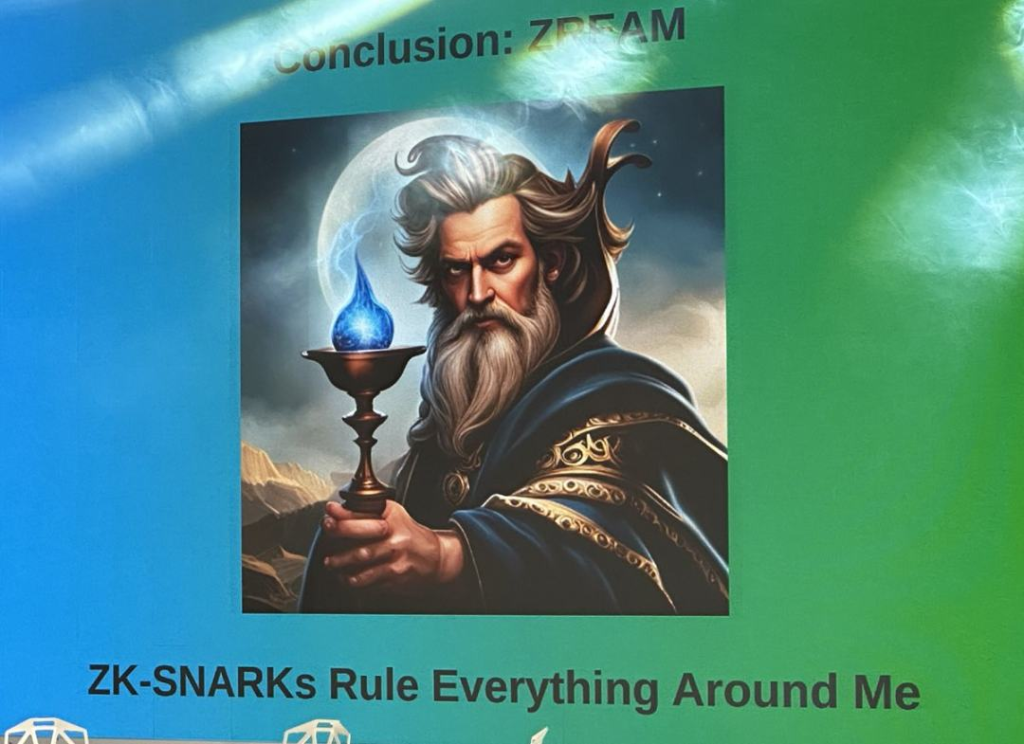
Source: https://foresightnews.pro/article/detail/33488
Many new players are joining the competition of zkEVM, which gains much traction
In the first half of 2023, several zkEVM projects have already gone live on the Ethereum mainnet, such as Polygon zkEVM, zkSync Era, and Starknet. Moving forward, the industry can expect more zkEVM projects to launch on the mainnet from the second half of 2023 to 2024. Projects like Scroll, Linea, and Taiko are currently in the testnet stage, gathering feedback from developers. These zkEVM projects received significant exposure and participation at the conference, with multiple mentions during speeches, including Vitalik Buterin’s. The developers of zkEVM demonstrated full of enthusiasm for their cause in this area. They shared the recent progress and goals of the project with the audience, and expressed their expectations for technological progress and product updates in the near future. The healthy competition in the industry is quite obvious to all. In the next 1-2 years, we will see zkEVM’s Layer 2 network continue to stand at the center of the Ethereum ecosystem.
Technical Lead Jordi Baylina of Polygon zkEVM shared the latest progress of the Polygon zkEVM project at the conference, including the improvement of the PIL2 (Polynomial Identity Language 2) language, and the data compression scheme being implemented to solve data availability (DA), emphasizing that Polygon zkEVM supports ERC-4337 (account abstraction) innately, and also shared his thoughts on the future landscape of Layer 2s. Jordi talked about the various data compression schemes adopted by Polygon zkEVM and the official approval of EIP-4844, which will further reduce costs. The combination of the two will greatly improve data availability on Polygon. In Jordi’s view, the industry will see more Layer 2 networks in the future, and the composability between L2s in the Polygon ecosystem will be realized through Proof Aggregation, which will help all L2 chains under Polygon to generate a single certificate to increase the composability between each other.
Kakarot, a zkEVM project, also attracted a lot of attention during and after the conference. It is a zkEVM project built on Starknet using Cairo language, and recently officially announced their successful fundraising. The reason for much attention is that Vitalik Buterin, Starknet co-founder and Starkware team members also participated in the investment. Kakarot co-founder, Elias Tazartes gave a public speech at the EDCON2023 conference, showing Kakarot’s cause and vision to the world. Vitalik Buterin also mentioned the Kakarot project in his speech. The highlight of the project is that it provides an EVM environment for Starknet based on Cairo language, so that developers of Solidity language can directly deploy applications to Starknet through Kakarot, without the need to program again in Cairo language. Kakarot created an EVM on Starknet which make possible that many excellent EVM projects can be quickly deployed on Starknet with only a little effort and time for developers to maintain the Cairo language and Solidity language code libraries. It sounds like Kakarot can become a Layer 3 on Starknet itself, but the team will first sprint for the Rollup-as-a-Service service in Q4 of 2023 in the near future. In an interview with Kakarot by Blockbeats, Elias said that the competition on the Layer 2 track will be more intense in the future. As a zkEVM platform, Kakarot will actively cooperate with Starknet, Polygon and Linea, etc. They also welcome Chinese developers of Solidity language and Cairo language to join in this field and work together.
Programmable cryptography has been called for many times
In addition to zkEVM, ZK technology is finding application in an increasing number of scenarios, and the demand for programmable cryptography is imminent. Programmable cryptography is officially proposed by 0xPARC. With the emergence and update of zk-SNARK and other cryptography tools, more general cryptography helps more developers to quickly implement application encryption (such as in digital identity, reputation, etc.) without having to learn and develop cryptography-based privacy protection technology. With more programmable cryptography development tools, privacy encryption will likely be applied to blockchain applications and off-chain calculations and models on a larger scale. In Jason Morton’s “What Is Unlocked by Practical Zero-Knowledge Proofs?” speech, he also mentioned “ZKP technology is becoming more and more programmable”. During the ZK panel, zero-knowledge proof and programmable cryptography were also mentioned many times by speakers such as Vitalik Buterin, and they are looking forward to this more general-purpose application of cryptography.
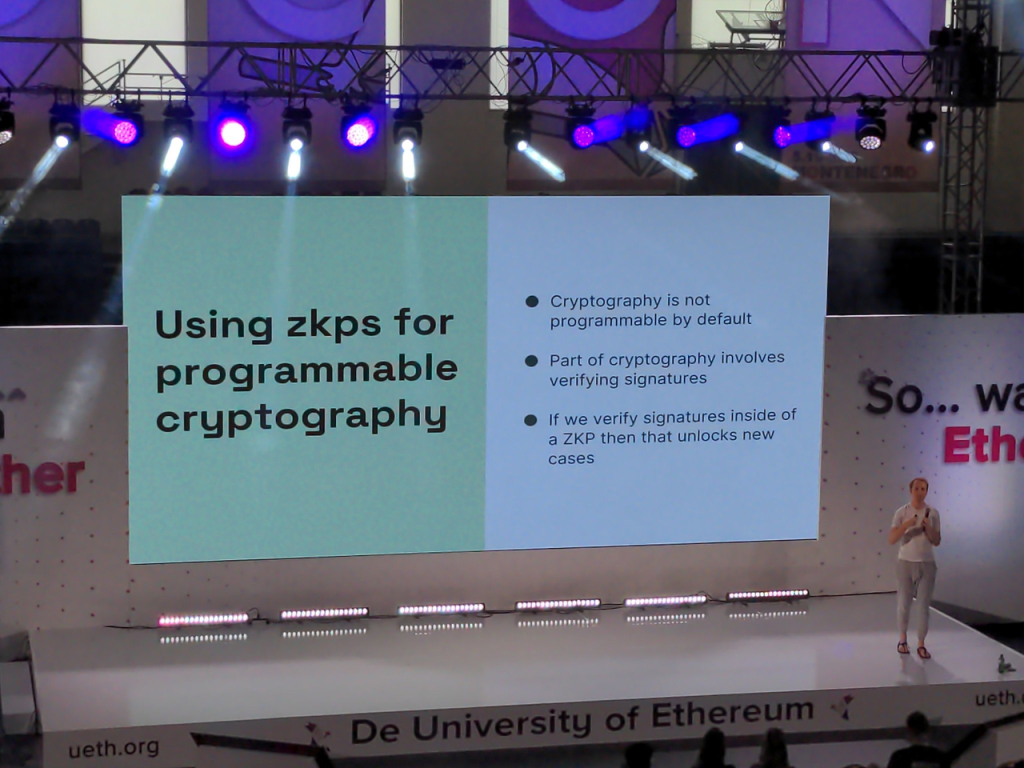
Source: https://twitter.com/search?q=programmable%20cryptography&src=typed_query

Source: https://twitter.com/madhavanmalolan/status/1660269927671156736
ZKML is in the early stage of development but has great potential
ZKML, which stands for Zero Knowledge Machine Learning, addresses the trust issues associated with machine learning models. Trust is a critical aspect in various aspects of machine learning, including the confidentiality of input and output data, algorithms, and model parameters. When trust issues exist, ML models are hindered from achieving larger-scale applications. For example, when a model uses user personal information as raw data for training, there will be encryption requirements for personal information. Another example is that, model parameters are usually the core competitive advantage of a product, and encrypting parameters and the model is necessary to keep the product moat. Zero-knowledge proof technology can provide proof for many things aside from smart contracts, especially when machine learning applications are becoming more and more common. ZKP can provide proof for an AI model with millions of parameters, thereby improving security and privacy protection , to help address various trust challenges. In addition, machine learning models require a lot of calculations. When ML models are integrated into on-chain applications, ZK-SNARK can be used to generate proofs to alleviate the computing power demand of ML and introduce AI into on-chain applications more efficiently. As artificial intelligence and machine learning further subvert our lives this year, ZKML is also believed to be more recognized by the public.
At EDCON2023 and many other blockchain conferences this year, many blockchain developers showed their interest and work in the field of ZKML (readers who are not so familiar with this concept can check out WorldCoin’s article on ZKML. As early as In the second half of 2022, WorldCoin teamed up with and some projects and researchers to create a ZKML community. The community introduced the concept, the advantages, and future prospects of ZKML to people at ETH Denver and other public events in 2023). At the first World Supercomputer Summit 2023 in Montenegro, most of the speakers were working on ZKML-related business. Cathie So (@drCathieSo_eth), a core member of PSE, introduced AIGC NFT EIP-7007 to the audience followed by some possible innovative applications driven by the combination of ZK and ML. Cathie further described how the future World Super Computer Architecture (World Super Computer Architecture) will empower ZKML implementation. The PSE team is committed to better combining and applying ZKP technology and the Ethereum ecosystem, and actively participates in the research and projects of building ZKML. In addition, Hyper Oracle (zkOracle project on Ethereum), Poseidon ZKP (ZK aggregation proof infrastructure), Modulus Labs (on-chain AI project development team), and WorldCoin’s DCBuilder were also speakers at the first WSC conference. Among them, Modulus Labs, as a pioneer in the field of ZKML, has conducted many experiments in the application of ZKML, including DeFi’s Rockerfeller Bot (the first full-chain AI trading robot), GameFi’s Leela vs the World (the first full-chain AI games) and NFT items, etc. On EDCON2023, as a developer in the field of ZKML, Jason Morton shared that he saw the huge progress in lifting FLOPS (Floating-point Operations Per Second) of ZKP in the past few years [Note], but Proof per Chain Transaction (the number of proofs in each on-chain transaction) is still at the tens of thousands level, and he expected a breakthrough in the next three years. He imagined that when Proof per Chain Transaction is further increased to a speed of 100 million or even 1 billion, there may be application scenarios combining ZK and blockchain in the fields of on-chain games, supply chains, and payment transactions.
Indeed, as highlighted by speakers at the conference, ZKML is still in its early stages of development. As one of the pioneers in the field of ZKML, WorldCoin organized the ZKML community, which has already attracted many developers and peers who are building in the field. When more products are driven by AI and more innovations come from the update of AI and ML, ZK can be used as a means of privacy protection and accelerating computation to further empower the AI-driven society. Although the demand of ZKML is not very obvious at present, the encryption and ZK Proofing of data, model and algorithm will be rigid needs in the future, if we have foreseen the ubiquitous world of AI. There will be more programming tools in the market that can help developers create ZK proofs for AI models without having to learn all the cryptography skills and knowledge about ZKP, which will open up a huge market for more ZKP DApps. The significance of the blockchain to AI or ML will also be multi-level. The blockchain itself can provide immutable and decentralized on-chain records, and the cryptocurrency itself can also become a key asset in the future world where AI and humans coexist, providing a currency system without borders.
[Note]: FLOPS, the number of floating-point operations per second, also known as the peak speed per second, floating-point operations per second, abbreviated as FLOPS. It means the number of floating-point operations performed per second, commonly used to measure computer computing speed or used to estimate computer performance.
DApp
At the EDCON2023 conference, more discussions were about the infrastructure while only a few were about decentralized applications (DApps), among which on-chain games, account abstraction, and LSD accounted for the majority.
From On-Chain Gaming to On-Chain “AI” Gaming
For DApps, most people showed high expectations for on-chain gaming. At the conference, when zkEVM builders and developers were asked about which on-chain applications they thought had the biggest potential, on-chain gaming was on the top of the list. When Danilo Kim shared his life experience in Zuzalu at the conference, he mentioned Zuland and Zuzuland, two on-chain AI games, were born during Zuzalu. During Zuzalu and EDCON2023, what also attracted attention was an AI-based fully-on-chain game Network State released by Small Brain Games. It is a tabletop role-playing TRPG game much alike Slobbovia. From what I see, the industry’s focus has been pivoting from on-chain gaming to on-chain AI gaming.
The prominence of on-chain gaming in application discussions does not stem from its existing user base, but rather from the market’s thirst for innovation and captivating narratives. Following the DeFi summer, the intensifying competition among decentralized exchanges (DEXs) both horizontally and vertically has only reinforced the Matthew Effect. However, despite this, leading DeFi protocols have struggled to attract fresh users and capital. Consequently, if a public chain aspires to witness a surge in traffic, relying on conventional methods of onboarding top DeFi protocols may prove insufficient. Instead, it necessitates an infusion of fresh perspectives from beyond the confines of the crypto space, capable of catalyzing a new cycle of bullish market sentiment. In terms of NFTs, the NFT boom took place on Ethereum during the bear market period, but NFTs also lack innovation momentum. Projects focused on PFP NFTs demand significant operational efforts. NFT initiatives incorporating GameFi elements and metaverse narratives are still in the process of delivering tangible products. Utility and membership NFT segment requires a large number of traditional companies to bring new users and capital into the industry. This year, GameFi has witnessed increased integration of AI, with the incorporation of machine learning (ML) models enhancing the flexibility and depth of on-chain gaming experiences. Notably, the integration of ZKML technology, a long-standing hot topic, has garnered significant attention for on-chain gaming. However, regardless of the segment, any on-chain application aspiring for mass adoption during the bear market is likely to encounter additional challenges and require heightened efforts to achieve its goals. Consequently, when discussing expectations for on-chain applications, the emphasis lies more on the “expectation” rather than the immediate “application” itself.
Account Abstraction is highly competitive, but value capture is still challenging
The concept of Account Abstraction (AA) emerged shortly after the birth of Ethereum. In recent years, progress in AA-related protocol standards, most notably the official deployment of ERC-4337 in March 2023, has reignited interest in this concept, attracting much entrepreneurship and investments. However, the status quo of AA is that it’s been quite “crowded” and there is fierce competition. The current players face challenges in value capture and business models.
During EDCON2023, Antalpha Labs held a HackerHouse event about Account Abstraction, and invited many developers, investors, and researchers in the field of AA to share their views and interact on the spot, including Compass DAO, Candide Wallet, Account Labs (the merged entity of Unipass and Keystone) and Mantle Network, Mirana Ventures research team, etc. I personally learned a lot about AA after attending HackerHouse events and gained a deeper understanding of the current progress of the segment. I highly appreciate Antalpha Labs’s work in organizing this amazing event and making it open to the public.
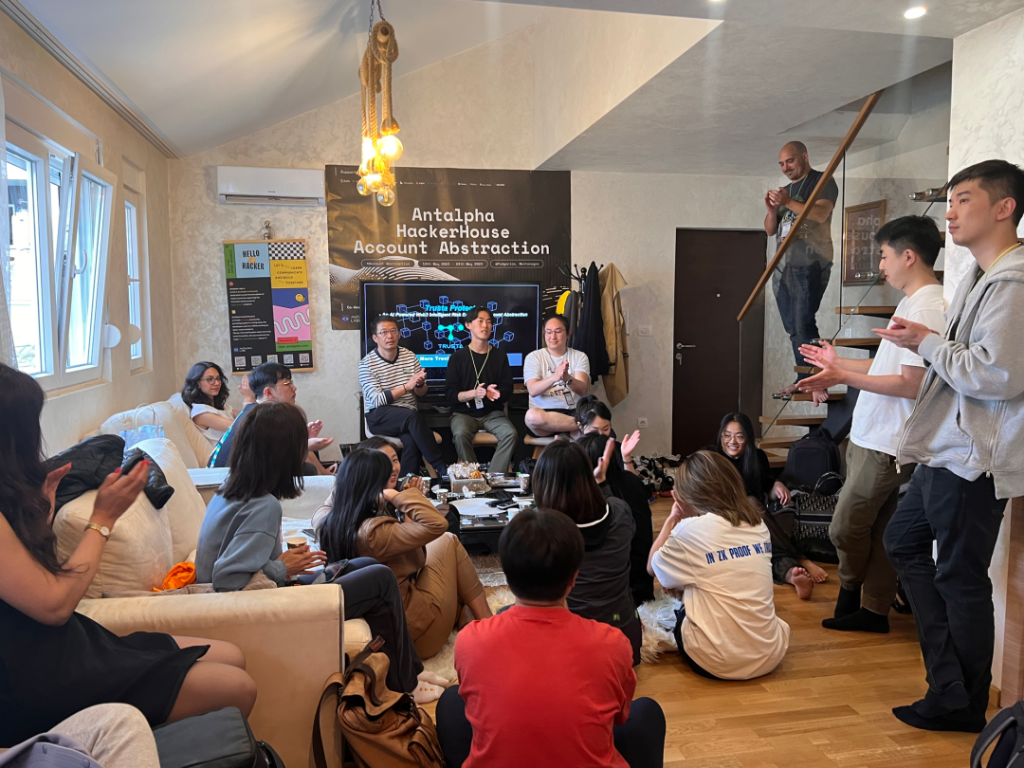
Source: https://mp.weixin.qq.com/s/kYMkw1lhP0ywp6e35NRqvw
At present, numerous wallet teams, public chain teams, and aspiring entrepreneurs are actively engaged in advancing the implementation of account abstraction. Following the EDCON Community Day and AA HackerHouse, several account abstraction projects left a lasting impression, highlighting the segment as being “flat, hot, and crowded.” The term “flat” denotes the minimal differentiation observed among various teams and projects at a technical level. In other words, there is no clear frontrunner or standout product in the market, as the playing field appears to be relatively level. “Hot” lies in the strong passion and interest of investors and entrepreneurs for the account abstraction wallet projects in recent years. The prominence of account abstraction is evident from its regular inclusion as a top topic at numerous blockchain and crypto conferences. In the future, more smart contracts will naturally use AA SDK to develop primitive wallet settings. Those built-in wallets in DApps would be account abstraction natively. Public chains are more inclined to support account abstraction and some have already incorporated AA, such as Starknet and zkSync. It is also “crowded” due to too many wallet projects, which makes the competition extremely fierce.
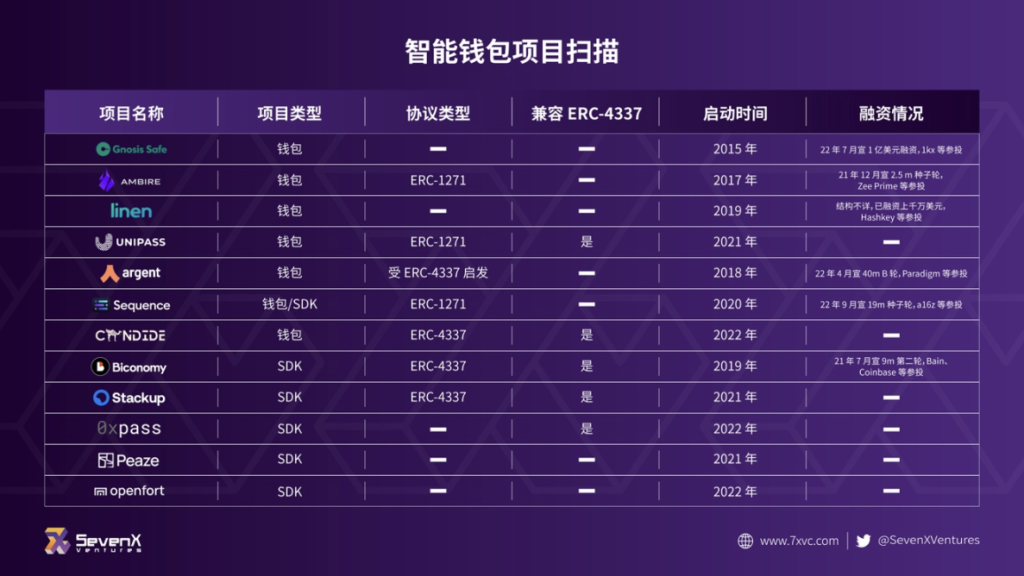
Source: https://foresightnews.pro/article/detail/23205
Multiple wallet teams in the AA segment have developed excellent products. However, in terms of technology and development progress, there is no single project on the track that is difficult to catch up. All competitors seem to keep similar progress. There are multiple SDK providers, such as Gnosis Safe, Biconomy, Alchemy, Web3Auth, Etherspot, and other teams. Almost all wallet projects that have appeared in recent years are developed based on the ERC-4337 protocol, and show determination in paying more attention to the developer experience and the user experience under the B2B2C business model. In terms of functionality, social recovery, anti-censorship, no mnemonic phrase, privacy protection, multi-chain support, and other functions are almost a must for AA wallet project, which could not differentiate anyone from others. In addition to SDK providers, wallet projects have also made a lot of attempts and efforts to explore more applications of account abstraction. The tool of AA is more than the need for it for the time being. When account abstraction wallets are more widely used in smart contracts, the smart contracts (business side) that capture large traffic on the customer side will allow AA wallets to capture value. This is also the reason why AA wallets are trying to develop more applications, expanding business vertically. In addition to building applications, some wallet projects are also working hard to build infrastructure, including developing SDKs, in an effort to acquire more customers with better reputation. However, the value capture for these projects is challenging. Many SDKs are public goods. Some projects provide wallet-as-a-service but find it hard to scale. MEV revenue for wallets also faces competition from primitive MEV projects. Many leading wallet teams are also exploring new ways to capture value in the industry chain.
With the official deployment of ERC-4337, account abstraction has gradually been implemented into applications. Protocol implementation is an important link to improve UX and US on the chain, and will be an important tool to bring about mass adoption. The current account abstraction segment is highly competitive. Both SDKs and DApps are working hard on attracting more new users. The B2B2C business model of the wallet is gradually taking shape, but effective economic value capture models for wallets need to be discovered in order to sustain the business.
LSD is considered as long-term stable investment
On-chain gaming is the most discussed application among developers in public speeches, while LSD and LSD-Fi are the topics that I heard people discuss more after the conference. There were many speakers discussing “distributed validators”. How to strengthen the decentralization of POS mechanism and the stability and security of nodes are technical points that developers continue to explore. In the process of communicating with investors at the conference, cryptocurrency funds showed more confidence in the LSD segments. The LSD business around POS mechanism is relatively more certain and stable, compared to other applications. You can read Mint Ventures’ research reports in the LSD field on our website through below links:
- After the Shapella upgrade: Yields, competition and the long-term impact of LSD-Fi
- pSTAKE Finance: A Multi-chain Liquidity Staking Protocol Backed by Binance
- Unpacking the Potential of Crypto Interest Rate Market with LSD Market Service Provider: Pendle
Takeaways
ZKML is on the eve of the outbreak, and more machine-learning applications will adopt ZK encryption in the future
In 2023, we are witnessing an increasing number of AI-driven products that are disrupting our traditional ways of living and working. As an important subset of AI, machine learning (ML) has been applied in many off-chain applications. There are challenges such as computing cost and speed, trust issues about data and model, and privacy protection in the exploration on the Internet. The ZK encryption method can enable the ML model to generate proofs for the model off-chain, and then support on-chain smart contracts, making the computation process more efficient, smart, and flexible. When ML enters the blockchain, we shall have more imagination about the future innovation.
In recent years, ZK technology has continued to mature in terms of software and hardware. A series of computing problems, trust challenges, and privacy protection issues that existed in previous machine learning (ML) models can all be solved with ZK methods. ZKML is also one of the fields that Sam Altman’s cryptocurrency project WorldCoin is striving to promote. WorldCoin and many research teams and projects in this field have jointly established the ZKML community to study and advance the technology and to explore application of ZKML.
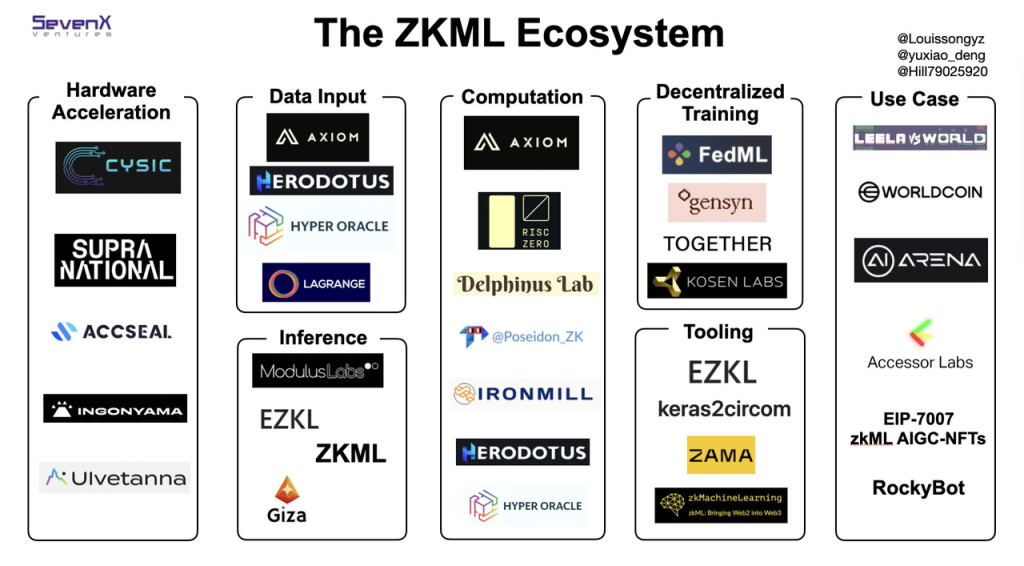
Source: https://appliedzkp.org/
Some existing ZKML applications are still in the early stages of development. As mentioned above, there are on-chain AI trading robots and on-chain AI games. In addition, off-chain ML models can be used to make suggestions on parameter settings for DeFi protocols. The zkDID project that WorldCoin is building is also one of the applications. It uses ZKML to ensure the privacy of biological information, and supports the future upgradeability of Iris Code. In the future, it is expected that we will see more machine learning models entering the blockchain field, and ZK technology will make this “future” come faster.
In addition, I attached a slide by Daniel, Founder of Modulus Labs, from his sharing at the WSC conference below. “(application) where AI is a good tool and trust is a barrier.” I believe this is the fundamental logic behind the combination of ZK technology and AL/ML. When the concepts of AI and ZKML become more popular, we will probably see various fake ZKML projects which may not create much value. By holding onto the fundamental logic and thesis of ZKML, we can avoid getting lost in the hype and bubbles.
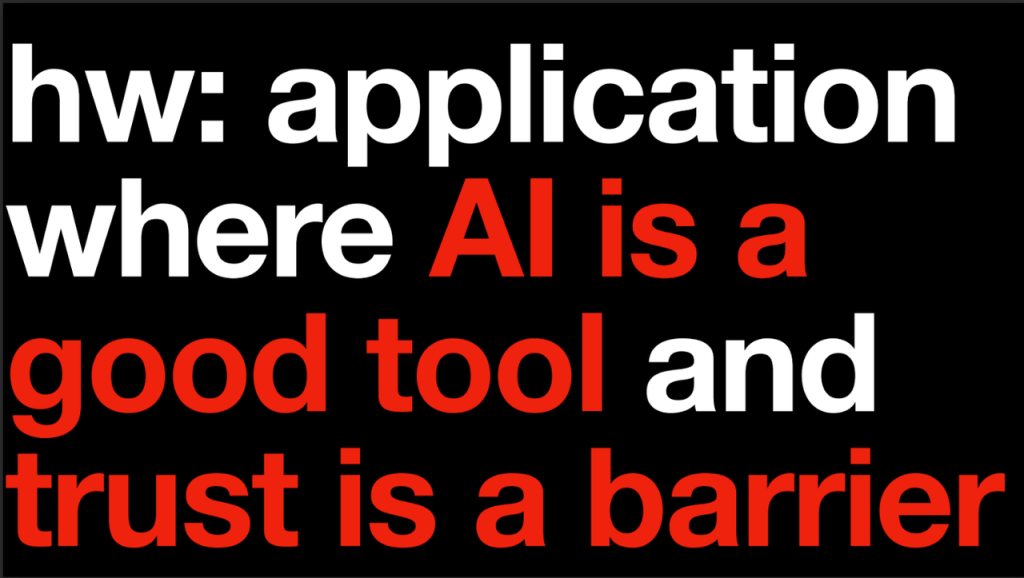
来源:https://drive.google.com/file/d/1KJ6csWNpwBPoy8DeJtW_2mY2Ii8h46yK/view
Account Abstraction track “flat, hot and crowded”
As mentioned above, it left me with a deep impression that the concept of account abstraction (AA) has made substantial progress so far. There is a notable presence of AA service providers in the market, and many wallet teams aspire to establish dominance by expanding their businesses vertically. A more profound challenge facing AA projects is the value capture system. As mentioned above, fierce competition and open-source culture make the account abstraction SDK a public good. The account abstraction wallet-as-a-service business for tons of smart contracts is difficult to scale. The end-user traffic of the wallet is still controlled by the smart contracts which means most value is probably spilled over to protocols rather than wallet providers. The value capture of account abstraction wallets has always been challenging. But for users, Ethereum will continue to promote the larger and deeper application of ERC-4337, bringing better user experience and user security. Looking ahead, I believe that account abstraction in the next cycle will no longer be a mere concept but will evolve into a captivating and seamless experience within high-traffic applications. This transformation is certainly something to look forward to as it promises to bring about significant advancements.
The important role of public goods in the blockchain industry has been mentioned many times
Among side events in Montenegro, Buidler DAO, SeeDAO and Mask Network jointly organized the DAO Montenegro Conference. One recurring topic of discussion was public goods. At the conference, Scott Moore, the founder of Gitcoin, also discussed public goods. He emphasized the importance of “coordination” in helping blockchain protocols solve network problems in the current society. (Gitcoin is an open source project funding platform. Its mission is to build and fund public goods in blockchain space.) I happened to have a chance to discuss public goods with Shumo, the founder of Manta Network and Poseidon ZKP, during the conference. “The endgame of blockchain infrastructure is public goods,” Shumo said. Some blockchain infrastructure can be seen as “quasi-public goods,” similar to roads, which have limited non-competitiveness and exclusivity. They should be widely utilized by society to enhance the financial system and overall work efficiency. The infrastructure codes in the industry are usually open source, due to the culture, as well as the equality and win-win spirit brought about by the Web3.0 concept. This makes it difficult for infrastructure projects to compete against each other with prices because infrastructure is as free as road. There will always be new open-source projects that will provide free positive externalities to the industry.
Another noteworthy impression from the conference was the altruistic nature of many developers and their focus on resolving problems and helping other projects. It is common to hear stories of startups in the crypto space that initially set out to address specific issues or provide assistance to other projects. Currently, most of the blockchain infrastructure is open-source public goods, which is one of the reasons why cryptocurrency and blockchain industries can iterate much more quickly than most others.

Source: https://www.youtube.com/watch?v=PHLP_T42840&list=PLe3T1ZflXe4GsxOvHAktPweug0qoBBtKz&index=3
Summary
Andy Guzman’s speech on “Harnessing ZK and Existing Infrastructure for Ethereum’s Mass Adoption” highlights the convergence of ZK (Zero-Knowledge) technology, account abstraction, and Layer 2 (L2) solutions. According to Andy, these developments have reached a stage where they can significantly enhance user experience (UX) and user security (US) while leveraging improved infrastructure. In Andy’s envisioned future, we can expect more flexible and interoperable decentralized applications (DApps) operating on faster, safer, and more stable Layer 2 solutions. This will be complemented by the integration of ZKP-empowered AI/ML technology and account abstraction wallets. Users will benefit from a safer, more convenient, and cost-effective account experience and interactive engagement within DApps. EDCON2023 is indeed an exceptional conference that gathers developers and industry peers from around the world. It provides an opportunity to review the current development progress and status quo of Ethereum, facilitates communication about the latest industry trends, and fosters the generation of innovative ideas. I eagerly anticipate the innovations and collisions that will take place at EDCON 2024 with all players!
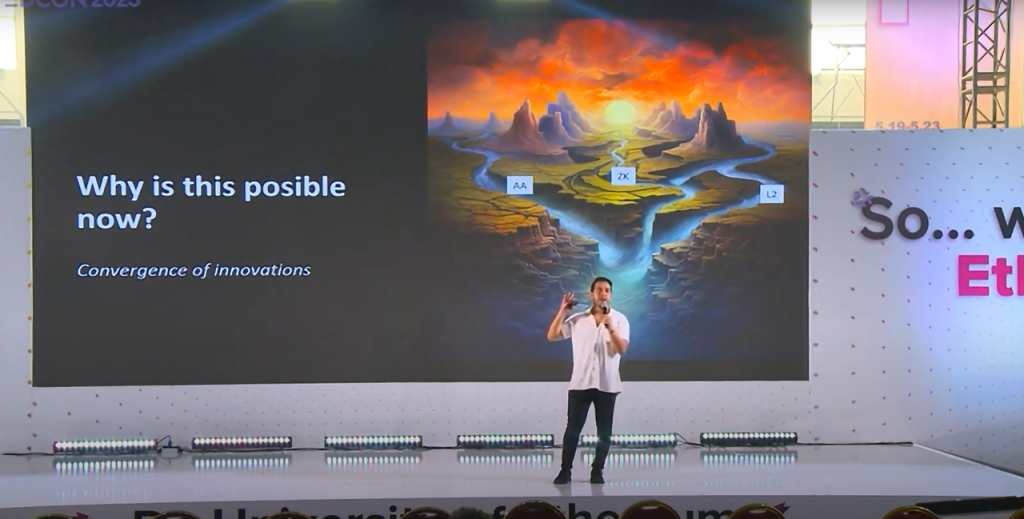
Andy Guzman is speaking on EDCON2023
Reference
- EDCON 2023演讲嘉宾和主题揭晓,V神、Balaji Srinivasan大牌云集 – 比特财经
- 一览以太坊黑山大会的热点趋势和重点关注项目
- 由币赢赞助的以太坊黑山大会周边活动DAO Montenegro完美落幕
- Vitalik Buterin:未来 10 年 zk-SNARKs 将与区块链一样重要 – Foresight News
- 为何Vitalik会认为未来10年zk-SNARK技术跟区块链一样重要?
- EDCON 2023:Vitalik Buterin演讲总结与优质项目盘点
- 一览以太坊黑山大会的热点趋势和重点关注项目
- 2023以太坊社区开发者大会:除却黑山,不见“明路”
- DAO黑山|与 Vitalik 共探全球危机下组织挑战
- “No Chinese”: 黑山EDCON中的傲慢与偏见
- 对话清华教授胡翌霖:超人类主义与Web3的哲学思辨
- EDCON官方推特
- V神已将其于2011年制作的某款游戏上传至IPFS;V神:不要让以太坊共识过载,否则会给生态系统带来高风险
- ZKPs and “Programmable Cryptography” by gubsheep | Devcon Bogotá
- 账户抽象 HackerHouse by Antalpha Labs
- Balancing the Power of AI/ML: The Role of ZK and Blockchain by SevenX
- De University of Ethereum YouTube Channel
- 以太坊钱包的变革:账户抽象与 ERC-4337 的机遇与挑战 – Foresight News
- zkML会是zk赛道的新方向吗?
- Privacy and Scaling Exploration
- May 18, 2023 – ERC-7007: a zkML case study @ World Supercomputer Summit
- Hyper Oracle在World Supercomputer Summit的演讲
- Shumo Chu/Poseidon ZKP在World Supercomputer Summit的演讲
- Daniel/Modulus Labs在World Supercomputer Summit的演讲
- https://www.youtube.com/watch?v=ZiLn5ReVFYc&list=PLe3T1ZflXe4GsxOvHAktPweug0qoBBtKz&index=12&pp=iAQB
- 关于Network States链上游戏的推特
- 一文读懂零知识机器学习 (ZKML) :ZK与AI将会碰撞出怎样的火花?
Acknowledgement
I’d like to thank all the interviewees for sharing their experience and takeaway with me. They are Derek from BTX Capital (@begas_btxcap), Jack from Blockbeats (@jack_xiong137), 0xMinion from GBV Capital (@0xminion), Ray from CypherBabel Index (@CryptoGOOO), Suede from Hyper Oracle (@hyperoracle), Shumo Chu from Poseidon ZKP (@shumochu), Tommy from Beosin (@TommyDeng_DAO), Hank from Bixin Ventures (@0xHankester), Qi Zhou from EthStorage (@qc_qizhou). I also appreciate proofreading work and discussion with Maxlion (@Real_Maxlion), Snappe Ye (@snapp_yebit), and Gigi (@realgigiyip) !



